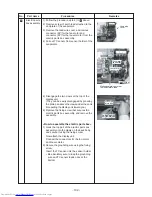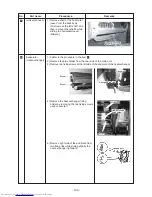
– 97 –
11-10-5. Checking Method for Each Part
MCC-5009
Soldered
surface
Heat sink IGBT side
C12
C13
C14
Resistance value
in good product
∞
Tester rod
+
–
~
2
~
3
~
2
~
3
–
4
~
~
~
+
–
~
1
1 2 3
(DBO1)
4
4
2
3
+
1
+
–
COM
COM
2
5
4
Y
W
BR BL
1
R
6
O
3
No.
5
6
7
Part name
ROutdoor temperature sensor
(TO), discharge temperature
sensor (TD), suction temperature
sensor (TS), outdoor heat ex-
changer temperature sensor (TE),
A room gas side temperature
sensor (TGa), B room gas side
temerature sensor (TGb)
4-way valve coil
(Model :VHV)
Pulse motor valve coil
(Model : CAM-MD12TF-6)
Checking procedure
Disconnect the connector, and measure resistance value with the tester.
(Normal temperature)
Temperature
Sensor
TD (k
Ω
)
TGa, TGb (Cooling only)
TO, TE, TS (k
Ω
)
TGa, TGb (Heat Pump) (k
Ω
)
10°C
20°C
25°C
30°C
40°C
100
64
41
27
18
20.6
12.6
10.0
5.1
3.4
20.5
12.5
10.0
5.3
3.6
Measure the resistance value of winding by using the tester.
Resistance value
1435 ± 144 W
Under 20°C
Measure the resistance value of winding by using the tester.
Position
Red - White
White - Orange
Blown - Yelloow
Blown - Blue
Resistance value
42 to 50 k
Ω
Under 20°C
No.
1
2
Part name
Electrolytic capacitor
(For boost, smoothing)
Diode block
Checking procedure
1. Turn OFF the power supply breaker.
2. Discharge all three capacitors completely.
3. Check that safety valve at the bottom of capacitor is not broken.
4. Check that vessel is not swollen or exploded.
5. Check that electrolytic liquid does not blow off.
6. Check that the normal charging characteristics are shown in continuity test by
the tester.
Case that product is good
Pointer swings once, and returns slowly.
When performing test once again under
another polarity, the pointer should return.
C12, C13, C14
→
760
μ
F/400V
1. Turn OFF the power supply breaker.
2. Completely discharge the four electrolytic capacitors.
3. Remove the diode block from the PCB (which is soldered in place).
4. Use a multimeter with a pointer to test the continuity, and check that the diode
block has the proper rectification characteristics.
10 to 20
Ω
when the multimeter probe is reversed
















































